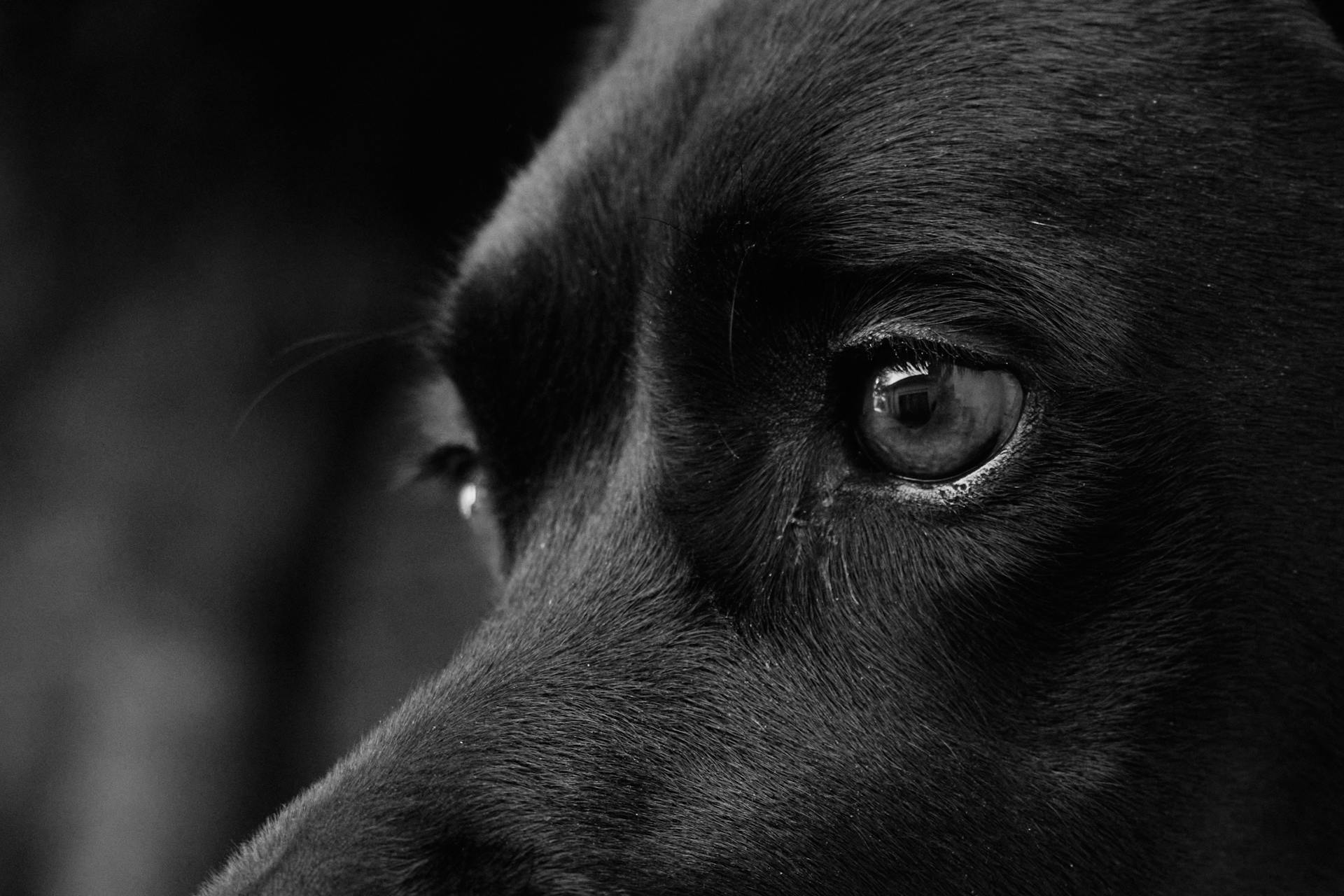
Canine eye cancer is a serious and potentially life-threatening condition that affects dogs of all ages, but it's most common in older dogs. According to statistics, over 4% of dogs over the age of 10 are diagnosed with eye cancer.
Eye cancer in dogs can manifest in different forms, including melanoma, lymphoma, and squamous cell carcinoma. These types of cancer can cause a range of symptoms, including redness, squinting, and discharge in the affected eye.
Some breeds are more prone to eye cancer than others, with the Scottish Terrier, Basenji, and Cocker Spaniel being among the most susceptible. Regular veterinary check-ups can help identify eye cancer early on, when it's more treatable.
Early detection is key when it comes to treating eye cancer in dogs. If you notice any unusual changes in your dog's eye, such as a sudden change in appearance or behavior, consult with your veterinarian right away.
Causes and Types
Canine eye cancer can be a complex and multifaceted issue, but understanding the causes and types can help pet owners and veterinarians take the first steps towards diagnosis and treatment.
Dog eye tumors can occur in various locations, including the eyelids, orbit, cornea, and uvea. Around 60% of canine eyelid tumors occur in the meibomian gland of the eyelids.
There are several types of dog eye tumors, including adenomas and adenocarcinomas in the eyelids, and uveal tumors, which originate from melanocytes in the iris, lens, and ciliary bodies.
Some common types of dog eye tumors include:
- Adenomas and adenocarcinomas in the eyelids
- Uveal tumors, including melanomas and other types such as venereal canine eye tumors and hemangiosarcomas
- Corneal tumors, which can occur in deeper corneal tissues and over the surface of the cornea
Dog eye orbital tumors, which cause an eye protrusion and pressure on the surface of the eye, are mostly malignant in nature and have a poor prognosis.
Types
There are several types of eye tumors in dogs, each with its own unique characteristics. Dog eyelid tumors are the most common type, accounting for around 60% of all canine eye tumors.

These tumors usually occur in the meibomian gland of the eyelids and can be either benign (adenomas) or malignant (adenocarcinomas). Other types of eyelid tumors include adenocarcinomas of the sebaceous glands and mastocytomas.
Eye orbital tumors in dogs are another type of tumor that causes an eye protrusion, leading to exophthalmia. This type of tumor is mostly malignant and affects almost all parts of the bony eye orbital structure.
Corneal eye tumors are the least common type of eye tumor in dogs, but they can occur in deeper corneal tissues and on the surface of the cornea. They are often confused with other conditions, so a confirmatory diagnosis is always recommended.
Uveal eye tumors, also known as dog eye melanoma, originate from melanocytes of the uvea, which resides in the iris, lens, and ciliary bodies. This type of tumor can cause changes in dog eye pigmentation, glaucoma, and an obvious mass on the iris and ciliary body.
Here are the main types of eye tumors in dogs:
- Dog Eyelid Tumor
- Eye Orbital Tumor
- Corneal Eye Tumor
- Uveal Eye Tumor
Each type of eye tumor requires a different treatment approach, ranging from surgical excision to enucleation or removal of the dog eye ball.
Dog Tumors: Types and Locations
Dog eye tumors can occur in various locations, including the eyelids, cornea, iris, and uvea. The eyelids are the most common site for eye tumors in dogs, with around 60% of canine eyelid tumors occurring in the meibomian gland.
Adenomas and adenocarcinomas are the most common types of eyelid tumors, and they usually cause irritation, discomfort, and obstruction in eye function. These tumors are often treated surgically with complete excision.
The cornea is another area where eye tumors can occur, and they are usually treated with laser photocoagulation, sclear grafts, or cryopathy. However, for mature and penetrated tumors, enucleation or removal of the dog eye ball only is required.
The uvea, which includes the iris, lens, and ciliary bodies, is also a common site for eye tumors in dogs. Uveal melanomas are usually benign, but about 20% of cases are malignant and require prompt treatment.
Here are the main types of dog eye tumors and their locations:
- Eye Lid Tumors: Meibomian gland, sebaceous glands, histiocytomas, papillomas, and mastocytomas
- Eye Orbital Tumors: Eye socket, causing exophthalmia (eyeball protusion)
- Corneal Eye Tumors: Deeper corneal tissues and surface of the cornea
- Uveal Eye Tumors: Iris, lens, and ciliary bodies, including melanomas and hemangiosarcomas
It's essential to note that some eye tumors can be confused with other conditions, such as canine keratoconjunctivitis and nodular fasciitis, so a confirmatory diagnosis is always recommended.
Diagnosis
Diagnosis is a crucial step in identifying canine eye cancer. A thorough ophthalmic examination, including the use of an ophthalmoscope, is typically the first step towards diagnosis.
Veterinarians will also take a complete medical history of your dog to help inform their diagnosis. This involves evaluating your dog's overall health and medical background.
Fine needle aspirate can be used to take a sample of the tumor, which is then examined under a microscope to help diagnose the type of cancer. This procedure is often used for solitary or multiple tumors that can be seen and felt.
Additional diagnostic testing, such as blood work, biopsy, and imaging studies like X-rays, ultrasonography, and MRI, may also be necessary to confirm the diagnosis and determine the severity of the tumor. These tests can help determine if cancer has spread to other parts of the body.
In some cases, veterinarians may need to sedate your dog to take a biopsy sample or remove the tumor entirely to get an accurate diagnosis. The sample is then sent to a laboratory for histopathology, where it is analyzed to determine the type and aggressiveness of the cancer.
Symptoms and Detection
If you notice your dog exhibiting any of the common symptoms of eye cancer, such as excessive squinting or blinking, it's essential to take your pup to the veterinarian as soon as possible.
Some common symptoms of eye cancer in dogs include pawing at the eye or rubbing it on furniture, discharge or excessive tearing, and cloudy or bloodshot eyes.
Early detection and diagnosis of eye cancer are crucial because most cancers are more amenable to being removed like tumors when they're detected earlier, when they're smaller, and less likely to have spread.
Here are some specific symptoms to look out for:
- Excessive squinting or blinking
- Pawing at the eye or rubbing it on furniture
- Discharge or excessive tearing
- Cloudy or bloodshot eyes
- Discoloration of the iris or pupil
- A bulging or swelling of the eye
- Visible growth in dog’s eye
- Swelling around the eye
- Eyelid abnormalities
- Vision problems or loss of vision
- Difficulty seeing in low light
Early diagnosis and treatment can help minimize the chances of vision loss and other health problems.
Symptoms
If you notice your dog exhibiting any of the following symptoms, it's essential to take them to the veterinarian right away. Excessive squinting or blinking can be a sign of eye cancer in dogs.

Pawing at the eye or rubbing it on furniture is another common symptom of eye cancer. This behavior is often a sign that your dog is trying to alleviate discomfort or pain.
Discharge or excessive tearing can also be a symptom of eye cancer. This can be accompanied by a cloudy or bloodshot eye.
A bulging or swelling of the eye, visible growth in the eye, or swelling around the eye are all warning signs that something is wrong. These symptoms can be indicative of eye cancer or uveitis.
Vision problems or loss of vision can be a sign of eye cancer or uveitis. Difficulty seeing in low light can also be a symptom of these conditions.
Here are some common symptoms of eye cancer and uveitis in dogs:
- Excessive squinting or blinking
- Pawing at the eye or rubbing it on furniture
- Discharge or excessive tearing
- Cloudy or bloodshot eyes
- Discoloration of the iris or pupil
- A bulging or swelling of the eye
- Visible growth in dog’s eye
- Swelling around the eye
- Eyelid abnormalities
- Vision problems or loss of vision
- Difficulty seeing in low light
- An abnormal pupil shape or red and cloudy eye
- The iris may change color or appear fluffy and swollen
Early Detection Matters
Early detection matters because most cancers are more amenable to being removed like tumors. If they're detected earlier, when they're smaller, they're less apt to have spread.
Catching cancer early can lead to higher cure rates. Not having the cancer spread is often based on how soon it's caught.
Early detection allows for treatment options like surgery or chemotherapy, depending on the tumor type.
Treatment
Treatment for canine eye cancer depends on the location, type, and extent of the cancer, and may include surgery, noninvasive laser surgery, radiation, chemotherapy, cryotherapy, or removing the eyeball.
Surgery is a common and effective treatment plan for most dog eye tumors, and both benign and malignant types usually require surgical excision to halt further cancerous developments.
Cryosurgery, which involves exposing eye tissues to extreme cold, can be used in combination with other approaches like medical and radiative treatments to effectively treat eye tumors in dogs.
High doses of local and general non-steroidal anti-inflammatory drugs (NSAIDs) and anti-cancerous drugs can help reduce symptoms and the development of cancerous tissues, and are commonly used for malignant and uveal tumors or those that have spread to the eye from other parts of the body.
Some cases of eye cancer may require enucleation, or the surgical removal of the eye, which can make the dog more comfortable, allow for a definitive diagnosis, and reduce the risk of cancer spread.
Dogs can adapt remarkably well to having an enucleation, especially since their other senses are so keen, allowing them to adjust to life without one eye.
Intriguing read: Lymphoma Treatment Cost for Dogs
Frequently Asked Questions
What is the prognosis for eye cancer in dogs?
The prognosis for eye cancer in dogs is generally good, especially if caught early, but it depends on the type of tumor and treatment. Early detection and treatment can significantly improve the chances of a successful outcome.
What does cancer of the eye look like in dogs?
In dogs, eye cancer can appear as brown or black spots or masses on the iris or a dark growth protruding through the pupil, often accompanied by other symptoms such as redness, squinting, or discharge. If you suspect eye cancer in your dog, consult a veterinarian for a proper diagnosis and treatment.
Is eye cancer in dogs fatal?
Uveal melanoma in dogs can be life-threatening if left untreated, but prompt treatment can improve chances of survival
Sources
- https://www.dog-health-handbook.com/eye-tumor-dog.html
- https://www.caninejournal.com/eye-cancer-in-dogs/
- https://www.ahofstatesville.com/services/dogs/dog-cancer
- https://www.springhouseanimalhospital.com/site/blog/2021/11/18/tumors-in-dogs
- https://envisioneyevet.com/the-dreaded-red-eye-5-serious-causes-in-dogs/
Featured Images: pexels.com


